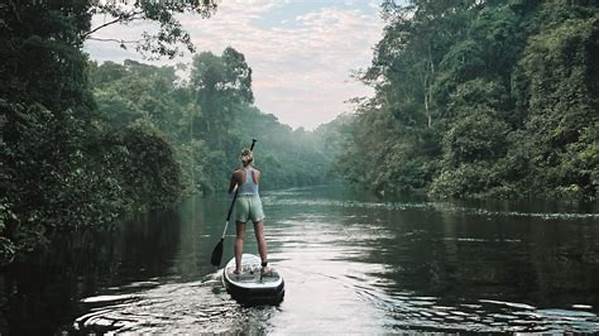- How Indonesian Nature Tourism Conservation Programs Gained Admiration
- The Role of Technology and Research in Conservation
- Community Engagement: The Human Element
- Indonesian Nature Tourism Conservation Programs: A Model for Others
- Summarizing the Success of Indonesian Nature Tourism Conservation Programs
In the bustling world of tourism and environmental conservation, Indonesia stands out as a beacon of innovation and commitment. With its rich biodiversity and stunning landscapes, the nation has long captured the fascination of travelers worldwide. But what truly sets it apart in 2025 is its cutting-edge approach to nature tourism conservation programs. These initiatives not only aim to protect Indonesia’s lush environments but also to showcase its unique selling points, drawing both attention and admiration from global audiences.
Read More : Volunteer Movements For Beach Cleanups
Imagine a place where tourists can marvel at pristine jungles while contributing to their preservation. Picture programs so effective that they gain international acclaim. It’s not fantasy—it’s Indonesia’s current reality. In this blog post, we dive into the intricacies that define these admired programs. You’ll uncover the stories behind the transformations, hear testimonials from participants, and gain insights into the strategies employed. Whether you’re a passionate conservationist, a curious traveler, or a smart marketer, this exploration will pique your interest, fuel your desire to learn more, and perhaps even inspire action towards sustainable tourism.
How Indonesian Nature Tourism Conservation Programs Gained Admiration
Over the past few years, Indonesia has been at the forefront of integrating conservation with tourism. But why are these programs admired in 2025? The answer lies in their innovative strategies and compelling narratives that resonate with both locals and visitors. By conducting rigorous research and employing the latest technology, these programs present a model of how conservation and tourism can coexist harmoniously.
One standout feature is the community-centric approach. Local communities are not just passive beneficiaries; they are active participants. Programs offer workshops and training sessions, turning villagers into tour guides and conservation advocates. This model not only educates but empowers, creating a sustainable ecosystem where wildlife thrives alongside human activity. Statistics show a marked increase in local employment and economic benefits, underscoring the programs’ success.
Moreover, testimony from international travelers highlights the positive impact. Tourists report transformative experiences where they not only enjoy breathtaking sights but also partake in conservation efforts. This dual benefit of enjoyment and contribution leads to advocacy and word-of-mouth marketing that extends the reach of these programs far beyond Indonesia’s borders.
The Role of Technology and Research in Conservation
The Tech-Savvy Approach
Today’s conservation programs in Indonesia don’t shy away from technology—they embrace it. Drones monitor forest health, while mobile applications provide tourists with ecological information in real-time. Innovations such as these offer a unique selling point that captures the attention of tech-savvy travelers and investors.
Environmental data collection has leveled up with satellite imaging and AI-powered analytics, allowing for more precise and proactive conservation measures. Research partnerships with leading universities ensure that programs are grounded in the latest ecological science, enhancing their credibility and effectiveness.
Field Research and Its Impact
In-depth field research forms the backbone of these successful initiatives. Researchers conduct longitudinal studies on specific species and ecosystems, helping tailor conservation strategies to fit unique regional challenges. These well-informed approaches resonate with visitors who value authenticity and realism in conservation efforts.
Community Engagement: The Human Element
Empowering Local Communities
Community engagement remains a core pillar of Indonesian nature tourism conservation programs admired in 2025. These initiatives depend heavily on local involvement, ensuring sustainability and cultural respect. Programs frequently include education, offering classes in English and ecology to local communities.
The locals become ambassadors for their environment, creating a ripple effect where education leads to awareness, awareness leads to action, and action leads to change. This grassroots empowerment multiplies the impact of conservation efforts, turning tourists into allies and locals into leaders.
Read More : What Makes Nature Tourism Posong Eco Tourism Village A Model For 2025
Visitor Interaction and Involvement
Tourists participate not as passive observers but as interactive participants. Volunteer opportunities abound, from beach clean-ups to planting native trees. These direct actions help foster an emotional connection between visitors and the environment, turning a simple visit into an impactful journey of learning and giving back. This narrative of shared responsibility and participation is both transformative and memorable for all involved.
Indonesian Nature Tourism Conservation Programs: A Model for Others
Indonesian nature tourism conservation programs admired in 2025 serve as an exemplary model for other nations seeking balance between tourism growth and environmental stewardship. Their success stems from a holistic strategy that combines public engagement, technological innovation, and ongoing research.
Innovative Features
Goals and Achievements
Challenges and Future Directions
Summarizing the Success of Indonesian Nature Tourism Conservation Programs
Indonesian nature tourism conservation programs admired in 2025 are a testament to what can be achieved through concerted efforts. These initiatives strike a delicate balance between enticing tourists and safeguarding natural habitats, showcasing Indonesia’s ability to innovate while preserving its unique biodiversity.
Key Takeaways
Vision for the Future
The future looks promising as Indonesia aims to expand these programs, sharing its model worldwide. The goal? To foster a global community that values and supports sustainable tourism.
An Invitation to Engage
As Indonesia continues its journey towards a sustainable future, it invites global citizens to be part of this transformation. Whether through visitation, investment, or collaboration, the story of Indonesian conservation is an ongoing one, with many chapters yet to be written.
Join the movement today and discover how you can contribute to the success of Indonesian nature tourism conservation programs admired in 2025.


